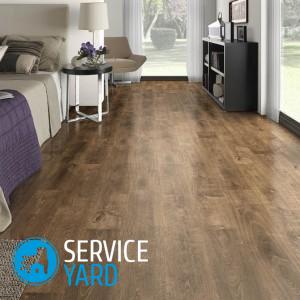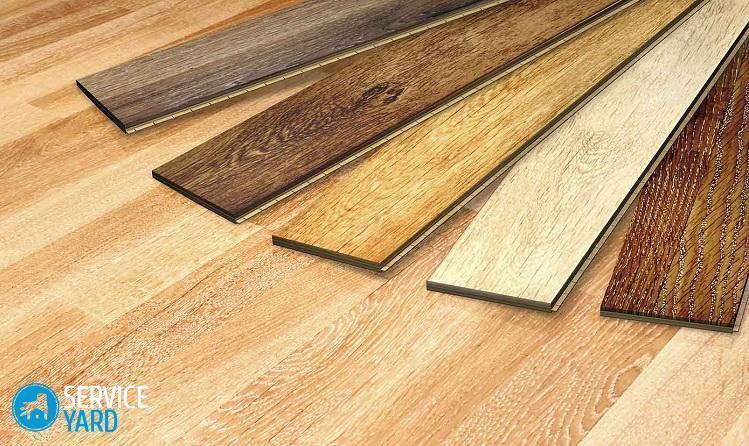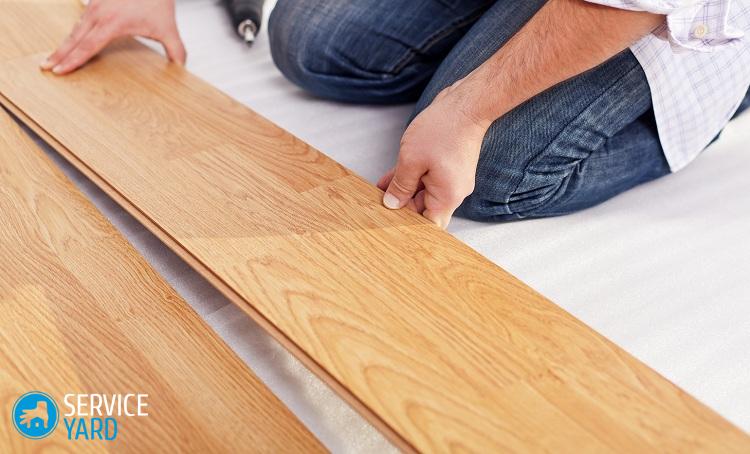Laminate thickness - which is better?

In recent decades, laminate flooring has become perhaps the most popular flooring. It is laid in apartments and offices, country houses and kindergartens. The abundance of colors and patterns allows you to design an interior in any style, and a special manufacturing technology has led to the appearance of a coating, the care of which does not take much time and effort. Different types of this material differ from each other not only in pattern, but also in other parameters. And not always the landlord can answer the question, the thickness of the laminate - which is better? Let's try to figure this out.
to contents ↑Layered cake
Puzzled by the problem, what thickness of the laminate is better to choose for an apartment, think about what the characteristic that interests you so much depends on. What is laminate flooring? This is a layered material. There are only four layers:
- stabilizing;
- carrier;
- decorative;
- protective.
The stabilizing layer is also called the bottom. Its task is to protect the coating from moisture, as well as increase its density. This layer is usually made of tarred paper. It is quite thin and does not have a large effect on thickness.
The carrier layer is the thickest, hardest and heaviest. It depends on it the total thickness of the structure. It is made from fiberboard. The top two layers are thin. For decorative use paper or foil. It affects the design of the room, but is not important for thickness and class. Finally, the task of the upper protective film, which is obtained from special resins, is to make the material as resistant as possible to wear and mechanical stress.
to contents ↑What to look for when choosing?
If you decide to abandon parquet, linoleum or ordinary boards and opt for a laminate, pay attention to three main characteristics:
- class
- thickness;
- brand.
Design, of course, is also important, but you should not buy the material immediately just because you like its color. Pay attention to the other characteristics, and then see if there is a higher class of material among the samples, similar to the one that immediately caught your eye.
What does a class mean?
On the price tag you will definitely see the numbers:
- 21;
- 22;
- 23;
- 31;
- 32;
- 33;
- 34.
They are a combination of quality parameters. Materials, the marking of which begins with a deuce, are intended exclusively for residential premises. They are inexpensive, but they wear out quickly. Lay in rooms where many people walk, they can not.
If you see that the marking begins with a triple, in front of you is a material intended for public buildings. The higher the class, the better the laminate. It will cost more than household. The most durable and reliable is class 34 laminate.
to contents ↑Important! Materials of classes 21 and 22 are unstable to moisture, among samples of class 23 you can find moisture resistant, and laminates for public buildings, as a rule, can be safely washed.
What is the thickness?
As a rule, low-grade laminate is thinner than that intended for public buildings. But still - what is the thickness of the laminate is better for the apartment? And what is the thickness? According to this characteristic, all laminates are divided into several types:
- thin;
- medium;
- thick ones.
Thin materials
Thin are considered laminates, the thickness of which is 6-7 mm. This may seem strange, but they have their advantages:
- ease;
- low price.
However, there are much more minuses:
- edges often break off;
- quickly erased;
- it can damage an object accidentally falling from above, not to mention sharp heels;
- the floor is cold, even if there is a good substrate;
- hard to make a flat surface;
- poor sound insulation.
Important! A thin laminate can be used for temporary floors - for example, in a country house. It is suitable for rooms where almost no one walks, there are no serious mechanical stresses and where the temperature is not particularly important. For example, such a material can be used to lay a large pantry, attic or basement.
Average thickness
Material with a thickness of 8-10 mm is considered average. This is a very high-quality laminate, it has practically no drawbacks, and if you are satisfied with other characteristics, you can safely lay it anywhere - in an apartment, in a cottage or in a country house with heating. It gives good enough sound insulation, and the floor does not cool too much.
Thick and durable
The most reliable and durable laminate has a thickness of 11-12 mm. Having made such a floor, you will get excellent sound insulation. This coating is resistant to severe mechanical stress, you can walk on it as much as you like. If you are going to make a warm floor - you only need such a coating, thinner materials will not work.
Of course, a thick laminate is more expensive than others. But this need not be feared. It is possible that he will serve you for twenty years, or even more.
to contents ↑Important! Now they produce laminated panels with a thickness of 13 mm and even more, but there is simply no need to lay such in the apartment.
Why is thickness important?
In the apartment, in principle, it is possible to lay any laminate - it is only important to distribute it correctly in different rooms. But still, let's see - and what depends on the thickness? Then it will be easier to understand which laminate thickness to choose for the home. From the thickness of the main layer, and therefore - of all panels, depend:
- the ability to create a flat surface;
- temperature in the apartment;
- soundproofing;
- strength and durability of the floor itself.
The thicker the material, the better they hold their shape. That is, a thick laminate bends much less than a thin and even medium one. Naturally, a thicker layer perfectly protects against extraneous sounds. Having laid a laminate with a thickness of 11-12 mm, you can be absolutely sure that you will not become an involuntary witness to everyday scenes from neighbors, and the gurneys from the lower floor will not spread your secrets around the world.
to contents ↑Important! As a rule, thick high-class panels are equipped with more reliable locks.
What to put where?
Having dealt with the main characteristics, think carefully about what thickness to choose a laminate for the rooms that you have in your home:
- hallway;
- kitchens;
- living room;
- children’s;
- bedrooms;
- a bathroom;
- glazed loggia.
Hallway
Let's start with the hallway. This is the face of your apartment, both households, closest friends, relatives, and random people get here. At the same time, everyone comes into the hallway, most likely in street shoes and several times a day.
What follows from this? Namely, that in this room there should be the most durable, reliable laminate, and it is desirable that it is still resistant to moisture. That is, thin material does not fit in any way, the thickness should be at least 8 mm, and better - 11-12 mm.
Kitchen
Despite the fact that the kitchen itself gives the house coziness, the environment in it is quite aggressive. There is a high temperature, steam, drops of fat, other troubles that happen even with the most accurate housewife. There are enough visitors here, but still not so much as in the hallway.
Laminate may be thinner, but it must be resistant to moisture. And it is very useful if it will give sufficient sound insulation. So you are likely to be comfortable with high-grade thick material.
Living room
Usually the owners pay more attention to the design of this room than to other characteristics of the materials that are used for decoration.But still the cold floor is unlikely to please the owners or guests. Conclusion - a thin laminate is not suitable. What about the rest? You can choose, taking into account the following considerations:
- guests and household do not enter in street shoes;
- this room is visited a little less often than the entrance hall, although often enough;
- there are almost no high temperatures, steam and drops of fat;
- there are occasionally friendly gatherings, sometimes with loud music and dancing.
From all this it follows that a laminate of class 34 and a thickness of 12 mm is not necessary here at all. The average laminate is quite enough - 8-10 mm is enough for the eyes.
Bedroom
The requirements for the cover intended for the bedroom are approximately the same as for the living room, with the only difference that there are even fewer visitors in this room. But the inhabitants of panel houses should consider several circumstances:
- need good sound insulation;
- the bedroom should be warm.
Important! Unfortunately, in panel houses, a thick laminate is indispensable. If you live in a brick house, then the bedroom may well have medium-thickness coating.
Children
They walk a little in this room, its main owners weigh a little, they don’t wear sharp heels, and even if it happens to them to enter their home in street shoes - it happens not so often. A particularly durable coating that will last two decades is not necessary here - in a few years, a charming kid will turn into a rebellious teenager, begin to rebuild the world in his own way, and it is possible that you will have to make repairs and change floors. Therefore, if the apartment is warm and there is no need to arrange additional heating from below, you may well opt for a thin laminate.
A bathroom
Despite the fact that ceramic tiles remain the most popular coating for bathrooms and toilets, many already lay laminate there. And in this case, the most important parameter is resistance to moisture and temperature changes. Choose the thickest material of the highest class, and you will not lose.
Balcony and loggia
The quality of the flooring depends entirely on how you plan to equip the additional living space. If there appears a room with a warm floor, there's nothing to be done - you will have to choose a coating with a thickness of at least 10 mm.
to contents ↑Substrate
Typically, a laminate is laid on a substrate. Why is this needed? There are several reasons:
- If there is a substrate, the screed does not have to be perfectly flat - no one will feel a 1-2 mm slope.
- Improved moisture protection.
- The floor cushions better.
- Sound insulation is becoming more tangible.
- The room is better kept warm.
Owners of rooms with low ceilings are usually worried about the question: will not an extra layer at the bottom steal a few precious centimeters? No, it will not steal. The floor will become only 2-3 mm thicker, so that even the inhabitants of Khrushchev will not feel any particular inconvenience. Moreover, the substrate should not be thicker than 4 mm. It is made from different materials:
- traffic jams;
- foamed polyethylene;
- polystyrene;
- bitumen;
- rubber.
to contents ↑Important! Sometimes the backing is made of wood, and then it can be a little thicker - up to 7 mm. In this case, you can choose a thinner laminate. If we talk about the total thickness, in this case it is from 8 to 18 mm.
Laminate of different thicknesses - is it possible?
The easiest way, of course, for all rooms in the apartment to choose a coating of the same thickness. But a simple way out is not always the best, and why spend extra money if you can save money, and quite significantly? It is quite possible to lay a laminate of different thicknesses, but several considerations need to be taken into account:
- The floor level in all rooms should be the same.
- Joints should not be noticeable.
All this is easily achieved if the substrates are chosen correctly - they can also be different. There is another possibility - to adjust the height due to screeds.
to contents ↑What else to look for?
The class and thickness say a lot about the quality of the coating, but still testing is carried out on a number of parameters. Considered:
- wear resistance;
- moisture resistance;
- impact resistance;
- burn resistance;
- Fire safety;
- resistance to dirt;
- influence on the material of mechanical influences;
Stock footage
You will find all these data in the certificate, which must be with the seller. Much is indicated on the labeling. But it should be borne in mind that, as a rule, thick and some average laminates correspond to high quality and for all other characteristics.
- How to choose a vacuum cleaner taking into account the characteristics of the house and coatings?
- What to look for when choosing a water delivery
- How to quickly create comfort at home - tips for housewives
- How to choose the perfect TV - useful tips
- What to look for when choosing blinds
- What should be running shoes?
- What useful things can you buy in a hardware store
- Iphone 11 pro max review
- Than iPhone is better than Android smartphones





